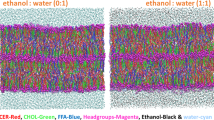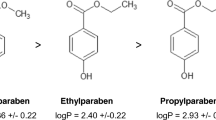Abstract
Purpose. This study aims to elucidate the skin permeation enhancement and the skin perturbation effects of a number of fatty acids, i.e. straight-chain saturated (SFA), monounsaturated (MUFA) and polyunsaturated acids (PUFA).
Methods. The skin permeation enhancement effects were studied using human stratum corneum (SC) and p-aminobenzoic acid (PABA) as a model permeant. The fatty acids in propylene glycol (FA/PG) were applied according to a pre-treatment/co-treatment protocol. The perturbation effects were studied using differential thermal analysis (DTA) on SC after pretreatment with FA/PG.
Results. SFA with 6 to 12 carbons exhibit a parabolic correlation between enhancement effect and chain-length, with a maximum at nonanoic-decanoic acids (with 9 and 10 carbons). Nonanoic and decanoic acids exert barely noticeable effects on the thermal behaviour of SC, suggesting that they easily mix with the skin lipids. All cis-6-, 9-, 11- or 13-octadecenoic acids (MUFA) enhance the permeation of PABA to the same extent. DTA revealed that the cis-9- and 13-isomers form a separate domain containing mostly the pure fatty acids within the SC lipids and suppress the lipid transitions at 70°/80°C. PUFA—linoleic (LA), α-linolenic (ALA) and arachidonic acids—enhance PABA permeation stronger than MUFA but additional double bonds do not further increase the degree of enhancement. LA and ALA form separate domains but do not completely suppress the SC lipid transitions at 70°/ 80°C. Increase in the enthalpy changes of 70°/80° transitions linearly correlates to the decrease in the permeability coefficients, suggesting that an increased perturbation of the skin lipids not necessarily has to yield an increased PABA permeation.
Conclusions. The enhancement effects of fatty acids on the PABA penetration through SC are structure-dependent, associated with the existence of a balance between the permeability of pure fatty acids across SC and the interaction of the acids to skin lipids.
Similar content being viewed by others
REFERENCES
B. J. Aungst. In E. W. Smith and H. I. Maibach (eds.) Percutaneous Penetration Enhancers, CRC Press, Boca Raton, 1995, pp. 277–287.
M. A. Lampe, A. L. Burlingame, J. A. Whitney, M. L. Williams, B. E. Brown, E. Roitman, and P. M. Elias. J. Lipid Res. 24:120–130 (1983).
K. W. J. Wahle. Proc. Nutr. Soc. 42:273–287 (1983).
H. Tanojo, P. E. H. Roemelé, G. H. Van Veen, H. Stieltjes, H. E. Junginger, and H. E. Boddé. New design of a flow-through diffusion cell for transdermal permeation studies in vitro. J. Controlled Rel. in press.
B. F. Van Duzee. J. Invest. Dermatol. 65:404–408 (1975).
H. Tanojo, J. A. Bouwstra, H. E. Junginger, and H. E. Boddé. Pharm. Res. 11:1610–1616 (1994).
M. Goodman and B. W. Barry. In R. L. Bronaugh and H. I. Maibach (eds.) Percutaneous Absorption, 2nd edition, Marcel Dekker, New York, 1989, pp. 567–593.
H. Tanojo, H. E. Junginger, and H. E. Boddé. Influence of pH on the intensity and stability of the fluorescence of p-aminobenzoic acid in aqueous solutions. Eur. J. Pharm. Sci. in press.
H. Tanojo, E. Boelsma, H. E. Junginger, M. Ponec, and H. E. Boddé. In vitro human skin permeability enhancement by oleic acid: Permeation of p-aminobenzoic acid and oleic acid across stratum corneum. submitted for publication.
J. A. Bouwstra, M. A. de Vries, G. S. Gooris, W. Bras, J. Brussee, and M. Ponec. J. Controlled Rel. 15:209–220 (1991).
T. Ogiso and M. Shintani. J. Pharm. Sci. 79:1065–1071 (1990).
R. Kadir, D. Stempler, Z. Liron, and S. Cohen. J. Pharm. Sci. 76:774–779 (1987).
G. M. Golden, J. E. McKie, and R. O. Potts. J. Pharm. Sci. 76:25–28 (1987).
R. O. Potts and M. L. Francoeur. Proc. Natl. Acad. Sci. USA 87:3871–3873 (1990).
H. Träuble. J. Membrane Biol. 4:193–208 (1971).
B. Ongpipattanakul, R. R. Burnette, R. O. Potts, and M. L. Francoeur. Pharm. Res. 8:350–354 (1991).
H. Tanojo, A. Bos-van Geest, J. A. Bouwstra, H. E. Junginger, and H. E. Boddé. In vitro human skin perturbation by oleic acid: studies using thermal analysis and freeze fracture electron microscopy. Thermochim. Acta in press.
B. J. Aungst, N. J. Rogers, and E. Shefter. Int. J. Pharm. 33:225–234 (1986).
V. Carelli, G. Di Colo, E. Nannipieri, and M. F. Serafini. Int. J. Pharm. 88:89–97 (1992).
P. Mukerjee. J. Phys. Chem. 69:2821–2827 (1965).
Author information
Authors and Affiliations
Rights and permissions
About this article
Cite this article
Tanojo, H., Bouwstra, J.A., Junginger, H.E. et al. In Vitro Human Skin Barrier Modulation by Fatty Acids: Skin Permeation and Thermal Analysis Studies. Pharm Res 14, 42–49 (1997). https://doi.org/10.1023/A:1012099216060
Issue Date:
DOI: https://doi.org/10.1023/A:1012099216060




